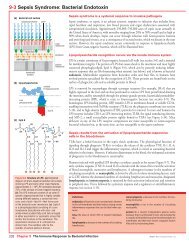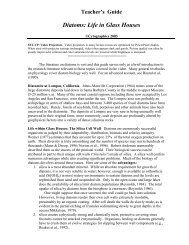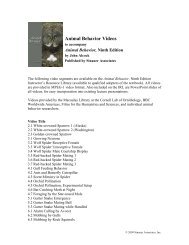Learning the Skills of Research:
Learning the Skills of Research:
Learning the Skills of Research:
Create successful ePaper yourself
Turn your PDF publications into a flip-book with our unique Google optimized e-Paper software.
Goals<br />
Exercise 6 (Student): The Collection <strong>of</strong> Behavioral Data<br />
1. To practice <strong>the</strong> two most common methods <strong>of</strong> behavioral data collection.<br />
2. To understand <strong>the</strong> situations for which each method is most appropriate.<br />
Susan W. Margulis<br />
Additional files on CD: Video clips <strong>of</strong> meerkats and gibbons, example data sheet.<br />
Background<br />
Now that you’ve learned <strong>the</strong> basic differences between continuous, focal sampling<br />
and instantaneous sampling, you will next have <strong>the</strong> opportunity to practice <strong>the</strong>se methods.<br />
In this lab, we will provide you with two ethograms (see Exercise 3 for more detail about<br />
ethograms and how <strong>the</strong>y are constructed). One is for meerkats (Suricata suricata) and <strong>the</strong><br />
o<strong>the</strong>r is for white-cheeked gibbons (Hylobates concolor). Familiarize yourself with <strong>the</strong>se<br />
ethograms.<br />
Methods<br />
Choose a partner to work with. Begin with <strong>the</strong> video clip <strong>of</strong> meerkats. Meerkats are<br />
a type <strong>of</strong> mongoose. They inhabit arid areas <strong>of</strong> sou<strong>the</strong>rn Africa, and live in groups that<br />
usually consist <strong>of</strong> several families. When foraging, one member <strong>of</strong> <strong>the</strong> group can usually












